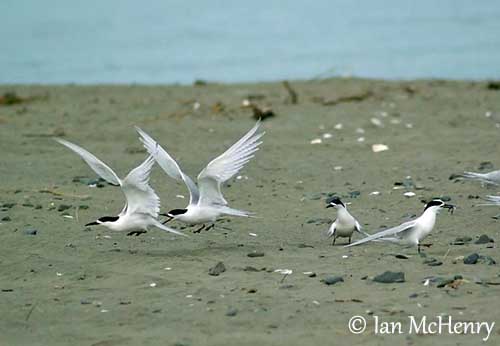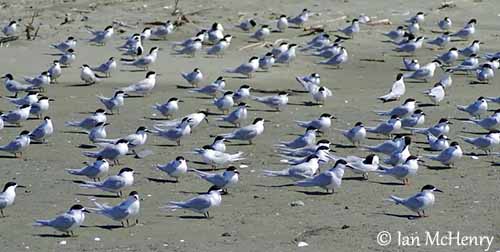
Fr: Sterne tara
Ang: White-fronted Tern
Maori: Tara
All: Weißstirn-Seeschwalbe
Esp: Charrán Maorí
Ita: Sterna frontebianca
Nd: Tarastern
Sd: Vitpannad tärna
Photographers:
Patrick Ingremeau
TAMANDUA
Ian McHenry
My New Zealand Birds
Otto Plantema
Trips around the world
Text by Nicole Bouglouan
Sources:
HANDBOOK OF THE BIRDS OF THE WORLD Vol 3 by Josep del Hoyo-Andrew Elliott-Jordi Sargatal - Lynx Edicions - ISBN : 8487334202
KNOW YOUR NEW ZEALAND BIRDS by Lynnette Moon - New Holland Publishers – ISBN: 1869660897
BirdLife International (BirdLife International)
New Zealand bird status between 2008 and 2012
Te Ara – The Encyclopedia of New Zealand
Birds in backyards (Birds Australia and Australian Museum)
Tiritiri Matangi Open Sanctuary
Birding West Coast – New Zealand
White-fronted Tern
Sterna striata
Charadriiformes Order – Laridae Family
INTRODUCTION:
The White-fronted Tern is very common in New Zealand, in a wide variety of sites along the coast but rarely inland. They are gregarious, feeding and roosting together, and forming large breeding colonies.

DESCRIPTION OF THE BIRD:
Biometrics:
Length: 42 cm
Weight: 160 g
The White-fronted Tern adult has pale grey upperparts, including the wings and the long, deeply forked tail. We can see a narrow dark band on the outer edge of the first primary.
The underparts are white, but there is sometimes a pale pink or rusty wash on the breast.
On the head, the crown is black whereas forehead and lores are white, like cheeks and chin.
The pointed bill is black. The eyes are dark brown. Legs and webbed feet are dark reddish-brown.
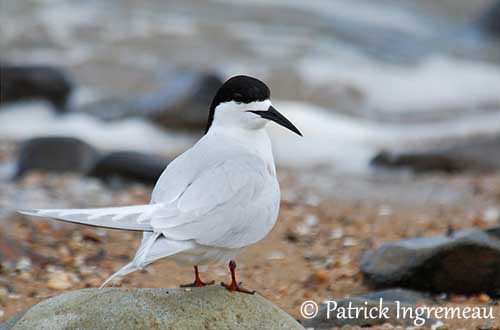
Outside the breeding season, the adult has broader white forehead, and the black crown is spotted white. There is a black spot before the eye.
Both sexes are similar in plumage, but the female is slightly smaller than the male.
The juvenile has fine blackish barring on back and upperwing-coverts.
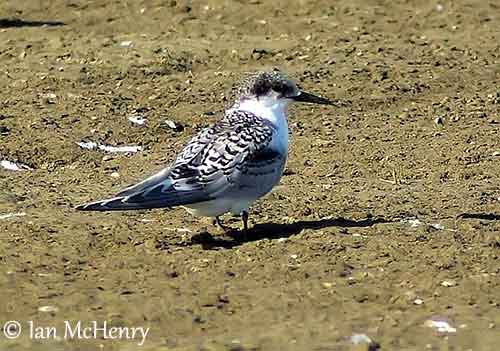
SUBSPECIES AND RANGE:
The White-fronted Tern has three subspecies with little difference in appearance.
S.s. incerta occurs on Flinders I and Cape Barren I, off NE Tasmania.
S.s. striata (described and displayed) is found on North, South and Stewart Islands in New Zealand.
S.s. aucklandorna (displayed) occurs on Chatham Is, Auckland Is and probably Snares Is too.
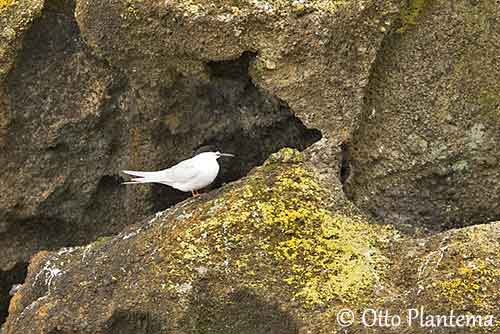
HABITAT:
The White-fronted Tern frequents numerous coastal habitat types such as sea cliffs, rocky headlands, harbours, estuaries, sandy beaches and dunes. It can breed on shingle islands in rivers and on deserted barges too.
This species feeds along the shores or in bays. It is more oceanic during winter.
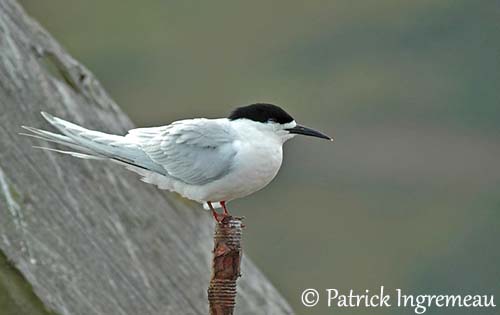
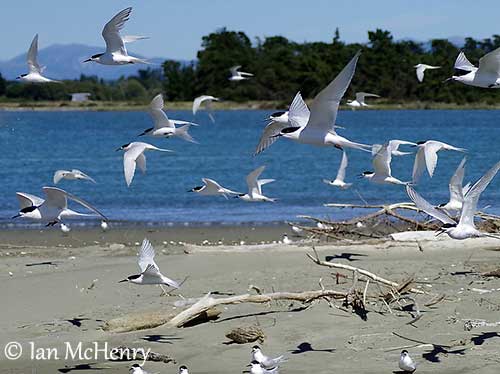
CALLS AND SONGS: SOUNDS BY XENO-CANTO
The White-fronted Tern’s common call is a sharp, rolling “krrrrik” whereas in flight, it often utters high-pitched, repeated “zitt-zitt”. While defending both nests-site and brood, the birds give harsh “keark” or “keeahk”.
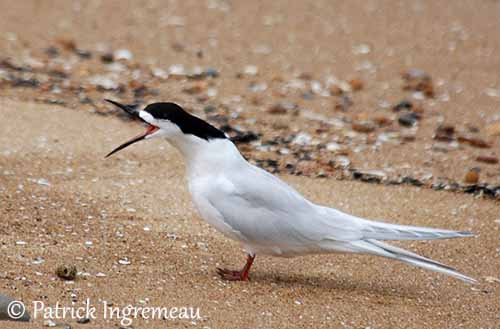
BEHAVIOUR IN THE WILD:
The White-fronted Tern has exclusive marine diet. It feeds on small fish, often pilchards and anchovies or pipers, and also shrimps.
It feeds both in lagoons and up rivers. It performs plunge-diving after a hovering flight some metres above the surface.
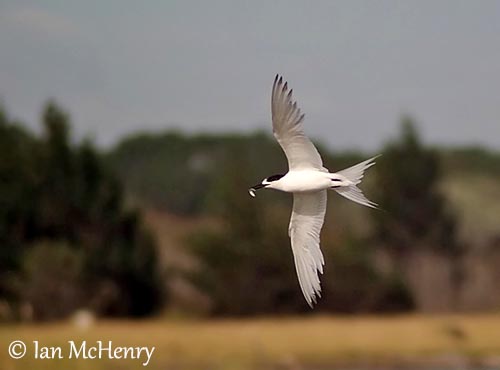
It usually joins gulls, gannets and shearwaters when large shoals of fish come near the surface. The White-fronted Tern hovers over the swarm, twisting and turning rapidly in the air before dropping down to pick the prey from the sea surface. It may plunge from 7-10 metres, but it also feeds by contact-dipping.
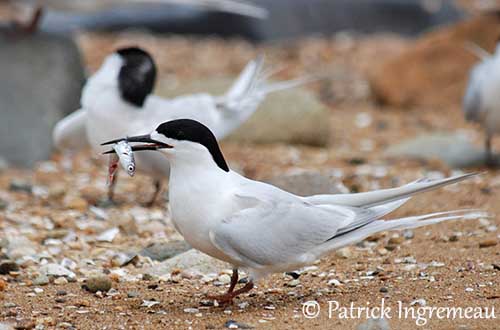
The White-fronted Tern usually forages alone, except at large shoals of fish. During summer, the Arctic Skua often pursues the terns and forces them to regurgitate the just caught fish.
They breed in colonies from 100 to 500 pairs along the coastlines. The pairs have long-term pair bonds, and usually return to their native colonies.
The male performs courtship feeding to the female before the laying. Usually, it gives her a small fish. The adults also display by walking together with outstretched neck, or they may dance around each other with drooped wings while calling softly.
The nest is strongly defended and both human and animal predators are repeatedly dived at.
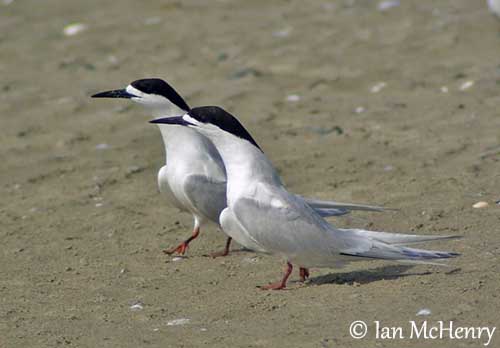
The White-fronted Tern may reach E Australia during winter, and is usually visible from S Queensland to Tasmania, and W to South Australia. There is some dispersion in New Zealand.
The race “aucklandorna” may reach Campbell Island.
These dispersions are mainly performed by immature birds.
This species has very acrobatic flight. Its small body and slim wings give the bird great manoeuvrability into the air. It flies with head and bill pointing downwards while searching for preys.
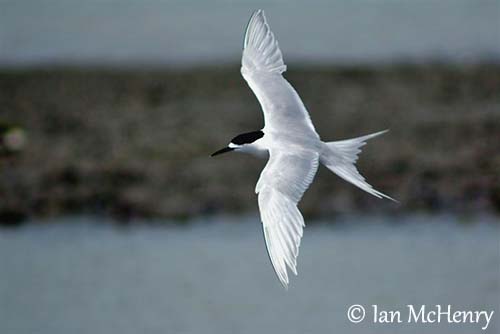
REPRODUCTION OF THIS SPECIES:
The breeding season takes place between October and February. The White-fronted Tern breeds in large, dense colonies along the coasts, on shingle or rock shelves, sandy beaches and dunes, or steep cliffs.
The nest is a hollow on the ground and usually, there is no added material. But the nest can be sometimes among the sand vegetation.
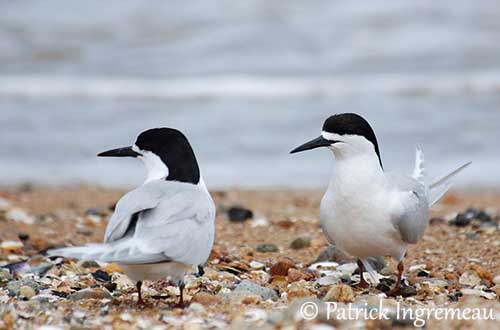
The female lays 1-2 greenish-blue eggs with dark markings. Both parents incubate during 24 days. At hatching, the chicks have whitish down overall, with blackish spots on head and upperparts. They remain at nest for a few days, before to join other chicks in a crèche. They are fed by both adults and can fly about one month after hatching. However, they still depend on adults for food for up to three months.
Eggs and chicks can be taken by cats and rats, and the adults are vulnerable to storms and bad weather conditions.
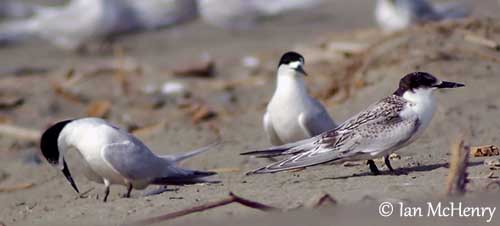
PROTECTION / THREATS / STATUS:
The White-fronted Tern has several predators such as stoats, ferrets, cats and rats. Eggs and chicks are sometimes taken by neighbours from adjacent colonies of gulls. Humans and their dogs often disturb the nesting birds at the colonies.
The population is estimated at about 24,000/30,000 mature birds, and the species is suspected to be declining.
But currently, the White-fronted Tern is evaluated as Least Concern.
